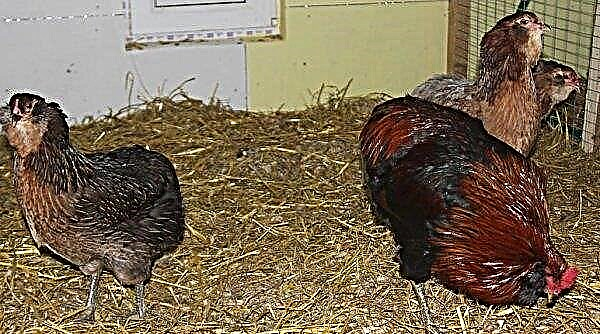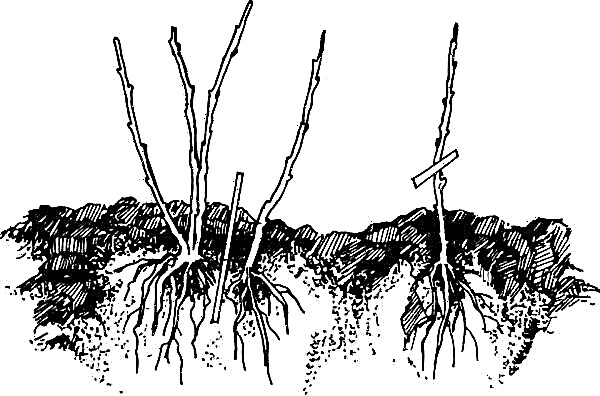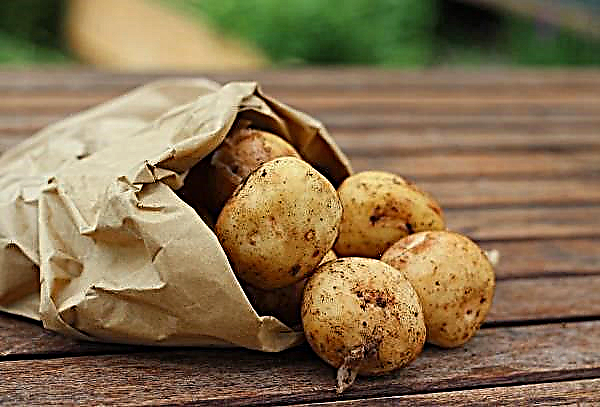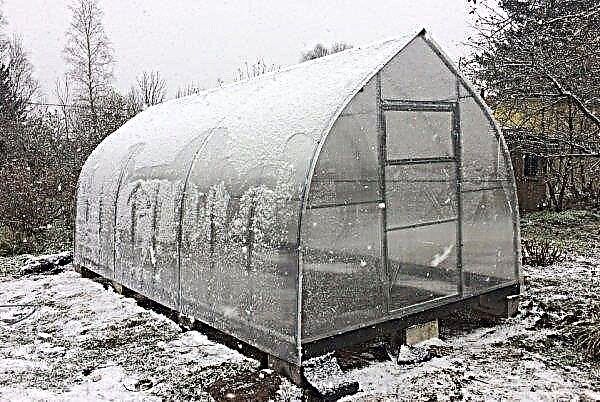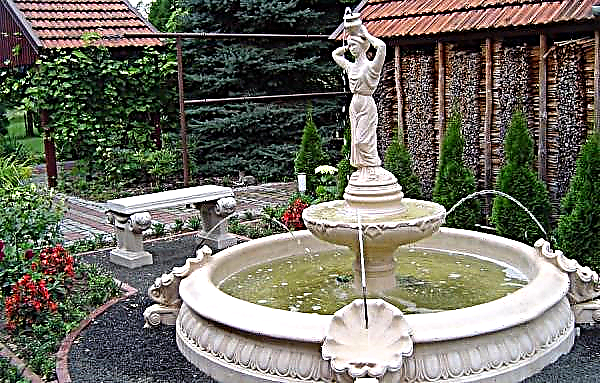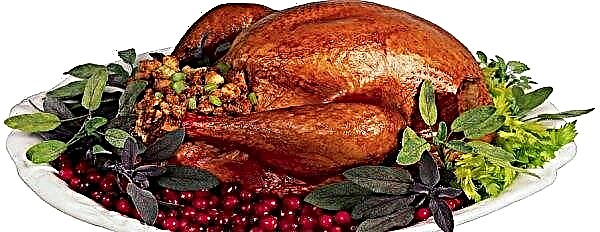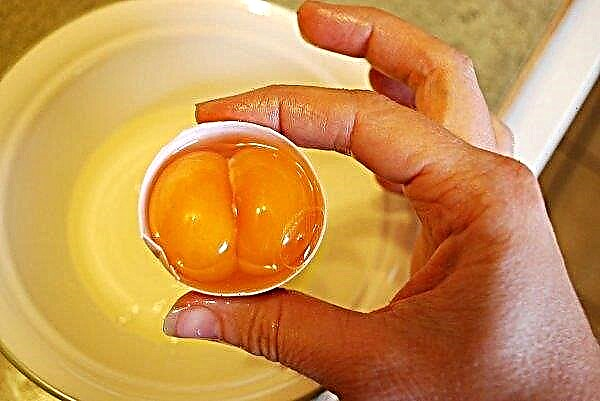Every summer, experienced and novice hostesses try to make supplies for the winter and preserve, salt and pickle all kinds of vegetables. Among the inhabitants of our country, among the most favorite winter preparations - tomatoes. In this article we will look at how to properly and tasty preserve tomatoes for the winter.
How to choose and prepare tomatoes for preservation
In order for seaming to work out, it is necessary to observe several rules for choosing tomatoes:
- Tomatoes are selected medium size, this is necessary so that all vegetables are pickled evenly.
- It is best to take a variety with not too dense, but not prone to cracking peel and a well-detached stalk.
- All fruits must be absolutely whole, without flaws (punctures, cracks).
- Optionally, can be preserved (together or separately) tomatoes of different varieties, with any skin color.
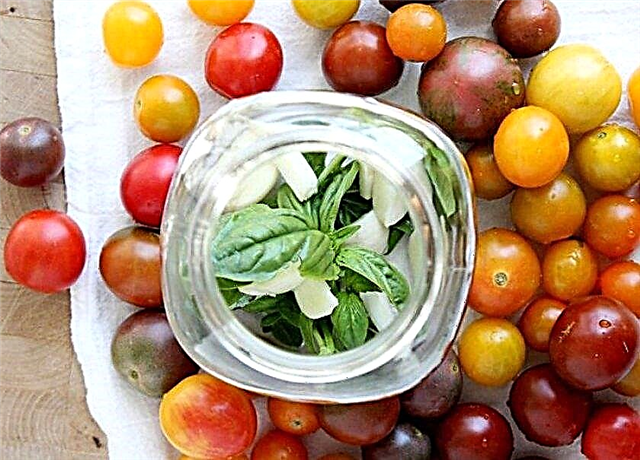
Primary processing of tomatoes before preservation:
- cleansing of the stalks;
- washing in water;
- sorting by size.
Did you know? Tomatoes are traditionally called vegetables, but these are fruits. Confusion arose in the 1890s when the US Supreme Court recognized them as vegetables. The contentious issue was the size of taxation. Fruits - this is the edible part of the plant, which contains seeds, vegetables - edible stems, leaves or roots.
The best recipes for canning tomatoes for the winter in banks
In order to preserve tomatoes, the following ingredients are most often needed:
- water, salt and sugar;
- wine, apple 6% or 9% vinegar;
- spice;
- greens (dill umbrellas, currant and cherry leaves, horseradish greens and parsley).
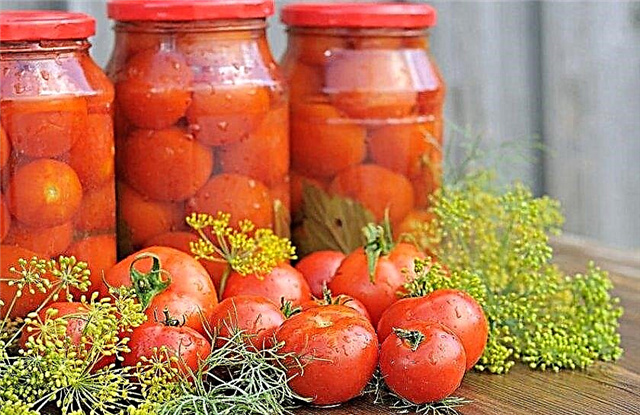
- gas or electric stove;
- a small saucepan with a volume of 1-1.5 l for sterilization on a pair of metal lids and glass containers or a basin with a wide bottom and high walls for pasteurization;
- a large pan with a volume of 5-6 liters for cooking brine;
- a lid with a special hole for steam sterilization of containers, which is placed on top of a small saucepan;
- plastic lid for cans with holes for draining hot water;
- glass containers with a volume of 1, 1.5, 2 and 3 liters (at the choice of the hostess);
- the required number of metal covers for rolling cans with a special rolling key;
- seaming key, knife, measuring cup with divisions, tablespoon, cutting board;
- a pair of kitchen gloves and a kitchen towel;
- kitchen stool as a platform for rolling cans.
Typically, in the classic version of canned tomatoes, sterilization of containers occurs in one of two ways:Did you know? Tomatoes are the richest plant source of lycopene, which is very important for male prostate health.
- for a couple;
- pasteurization in boiling water.
Pasteurization in boiling water
- A deep pan or metal basin with high sides is required, the bottom of which is covered with a soft cloth. The fabric is needed so that the glass bottoms of the containers do not crack, that is, it serves as a buffer between the glass and the metal bottom of the basin.
- They put cans filled with tomatoes in a basin and fill their contents with hot brine, after which they cover the neck with metal covers (without rolling up).
- Boiling water is carefully poured into a basin with containers in small portions. Ideally, the fluid in the basin should reach the shoulders of the glass containers.
- The basin with all contents is installed on the tile and turn on the fire. After some time, the water begins to boil. Further, the intensity of heating decreases, and pasteurization continues on a small fire. The pasteurization time is determined by the volume of glass cylinders and fully corresponds to the sterilization time for the same containers for a couple.
- After the set time has elapsed, the cans are taken out of hot water and rolled up with metal caps using a seaming key.
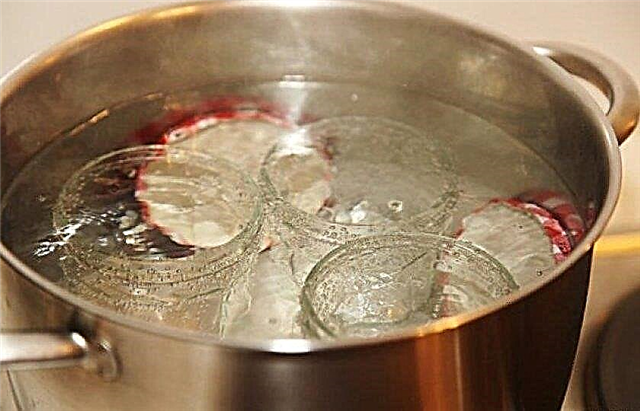
We will examine in detail how to preserve tomatoes using the more popular steam sterilization.
This technique is used for all types of marinades:
- Glass jars of the required volume are thoroughly washed with soap, rinsed in clean water and turned upside down on a kitchen towel.
- In a small saucepan designed to sterilize containers, pour 1 liter of water and bring to a boil.
- Then (without turning off the heating) cover the saucepan with a special coating with a hole for steam sterilization, on which a washed jar is placed down the neck. Steam from a boiling pan through the hole in the lid enters the tank and sterilization occurs. Sterilization time is determined by the volume of the glass bottle.
Important! A sufficient steam sterilization duration for cans with a volume of 1 liter is 10 minutes, with a volume of one and a half liters - 15 minutes, with a volume of 2 liters - 20 minutes, with a volume of more than 3 liters - 20-25 minutes.
- At the same time, a large volume pan filled with water is installed on the adjacent burner and allowed to warm to a boil. It will be needed in the future for warming tomato fill.

Classic way
Preliminary preparation:
- The onion is cut into large transverse rings, the cayenne pepper pod is cut into small particles (by the number of seals), bell pepper rings or strips. Tomatoes are washed in two or three waters and laid out on a table for drying.
- Each container contains: a few rings of fresh onion, a couple of allspice, a couple of black peppercorns, a slice of hot pepper and Bulgarian pepper, a lavrushka, a few dill umbrellas or horseradish leaves and fill to the top with tomatoes.
- Prepared and filled cans without brine are temporarily covered with sterilized metal lids.
The neck of boiled water containers with tomatoes is again covered with iron caps and left to warm for 15–20 minutes.

Then the slightly cooled water from the containers is poured into a free large pan. To drain boiling water from the cans of the hostess, they often use an ordinary plastic lid, in which arbitrary holes are cut with a knife. The same device can be purchased at any retail outlet.
This recipe is designed for rolling tomatoes into three-liter containers. After hot water was drained from the containers with tomatoes, the same water is returned to the stove and heated until it boils.
Then in each of the 3-liter jars placed:
- 60 g of salt;
- 50 g of sugar;
- 30 ml of vinegar (9%).
Cold without sterilization
The easiest way to harvest tomatoes for the winter is to pickle them coldly. Most often, 3-liter jars are used, each of which includes about 1.5 kg of medium-sized fruits. Washed empty cans undergo sterilization without fail.
At the bottom of the cans are placed:Did you know? There are more than 10,000 tomato varieties on the globe. The color of the skin and pulp is of different colors, including red, pink, dark lilac, black, yellow and white.
- several dill umbrellas;
- currant and cherry leaves (5 pieces);
- a couple of garlic cloves;
- several large leaves of horseradish;
- three to four peppercorns.

With bell pepper
Here is one of the old well-deserved recipes, tested by many housewives. Adding fragrant bell pepper to the pickle for preservation of tomatoes gives it a wonderful aroma.
Ingredients:
- water;
- 4–5 kg of medium-sized tomatoes;
- 5–6 large yellow or red bell peppers;
- 1 cayenne pepper;
- one large onion;
- some fresh parsley leaves;
- horseradish leaf;
- bay leaf;
- allspice peas;
- two garlic heads.
Important! It must be remembered that when filling the jar with vegetables, you need to leave 2-3 cm of free space to the top of the container so that the brine covers the tomatoes.
It is more convenient to make these seals by heating with boiling water and steam sterilization, therefore, after preliminary sterilization of glass containers and filling with fruits, the jars with the contents are filled with boiling liquid and warmed up for 15 minutes. Next, the liquid is drained and used for cooking brine, so the next step is very important - you need to know as accurately as possible the number of liters drained from the hot water tanks. Water is measured using an empty can. Based on the amount of water, the hostess determines how much sugar, salt and vinegar must be taken for cooking brine.
Ingredients for 1 liter of drained water:
- 3 tbsp. l sugar (with mountain);
- 1 tbsp. salt (with mountain);
- 100 ml of vinegar (9%).

- Water, salt and sugar are mixed in the required proportions, the mixture is brought to a boil and boils for about 3-5 minutes.
- Next, the right amount of vinegar is added to the boiling brine.
- The brine is brought to a boil, the saucepan is removed from the stove and poured into containers with tomatoes, which are immediately rolled up with tin lids using a sealing key.
- Rolled cans with canned tomatoes are wrapped in a warm blanket for the night.
- Cooled seams are taken out to a cool place (basement or cellar). Such preservation can be stored for 3–5 years, absolutely without losing taste.
In own juice
This recipe is simple, but requires some initial preparation. One of the benefits of canned tomatoes in tomato juice is complete non-waste. After all, after the jar is opened in the winter, tomatoes will be eaten and juice will be drunk.
Ingredients:
- 2 liters of tomato juice (own production or purchased);
- 4 kg of small plum-shaped or round tomatoes, the same size;
- 3 tbsp. salts;
- 4 tbsp. Sahara;
- two peas of black and allspice;
- 1 leaf of laurel tree.
Video: Recipe for harvesting tomatoes in your own juice
How to cook:
- For those who want to make tomato juice with their own hands, you need to take about 4 kg of large, meaty and tasty tomatoes. The fruits are placed in a colander and doused with boiling water (blanched), this makes it possible to remove the skin from them without difficulty. Next, the fruits are crushed using a blender. The resulting juice from tomatoes contains small seeds, it is desirable to separate them, so the juice is filtered through a colander for small vermicelli. Ready tomato juice is measured in portions and heated, gradually bringing to a boil. After boiling, pour salt and sugar into the juice and cook on low heat for up to five minutes. You can also use store juice in this recipe.
- We sterilize cans steamed in the same sequence as described in the classic recipe.
- A pair of peas of pepper and one bay leaf are placed at the bottom of the containers. A larger amount of laurel will give a concentrated and rather unpleasant taste to tomato juice.
- Simultaneously with the sterilization of the cans, a large pot of water is installed on the adjacent burner for heating, which must be boiled.
- Vegetables are placed in glass containers with spices and carefully (in small portions!) Are poured with boiling water so that the fruits are under the liquid and left to warm for fifteen minutes.
- Then the hot water is drained, and the jars are filled with freshly boiled juice, where salt and sugar have already been dissolved. Next, the tomatoes are rolled up with tin lids and wrapped in a warm blanket for the night.
Did you know? In Latin, the botanical name of tomatoes sounds like Lycopersicon lycopersicum, literally meaning “peach of the wolf”.
Sweet
Many people like tomatoes in a sweet marinade. In this recipe, all the components of the brine are measured not in grams, but in milliliters, in the same way as our mothers and grandmothers did before the scales appeared in the kitchens, and the tomatoes are very sweet and tasty.
Spice:
- dill umbrellas;
- Bay leaf;
- two peas of allspice;
- fresh onions;
- carrot.
- 250 milliliters of sugar (one faceted glass “with a belt”);
- 50 milliliters of salt (1/5 of the same glass);
- 50 ml of 9% vinegar (1/5 of the same glass).

Sharp
This recipe will appeal to lovers of a bright and burning taste, since a rather large amount of hot pepper, onion and garlic is used in the preparation of the marinade.
Ingredients:
- 2.5 kg of tomatoes;
- 600 g of onion;
- one large carrot;
- two large heads of garlic;
- one large bell pepper;
- two long red hot peppers;
- greens (dill, parsley).
- 100 g of sugar;
- 50 g of salt;
- vinegar to taste;
- 1 leaf of laurel;
- 2 pcs. sweet and black peas;
- 2 pieces of cloves.

How to cook:
- Cut the onion and carrot into rings, crush the peeled garlic through a garlic squeezer, cut the hot pepper into small pieces, and the bell pepper in strips. All vegetables, as well as bay leaf, allspice and black peas, cloves and greens are placed in a 3-liter jar and filled to the shoulders with pre-prepared tomatoes.
- Next, the containers with tomatoes are poured with very hot water, left for fifteen minutes to warm up. Then they drain the water and fill the fruits with the finished marinade. Cans are sealed with lids and wrapped in a warm blanket overnight. The result is remarkably delicious spicy tomatoes with crispy onions and carrots.
Did you know? More than half a million tomato seeds have traveled into orbit. After visiting the International Space Station, the seeds returned to Earth and were sown in home gardens of Canada in a series of experiments called “Tomatosphere I, II, III and IV.”
Useful Tips
In order to successfully preserve tomatoes, several recommendations must be observed:
- So that the shoulders and the neck of the cans are not empty, they can be filled with small cherry tomatoes.
- During pasteurization, the temperature of the liquid in the basin and the temperature of the marinade in the containers should be approximately the same.
- Before installing cans in a basin for pasteurization, it is covered with a kitchen towel. This will protect the bottom of the cans from cracking.
- Pouring boiling water into a jar, the housewife must be careful and pour hot water into several doses, with interruptions of one to two minutes.
- In liter jars, it is most convenient to preserve small tomatoes (weighing 40–80 g).
- Before placing ready-made preservation in the cellar, it must be allowed to cool to room temperature.
- Metal and tin lids for preservation are sterilized by boiling for 5 minutes.
- To know the year of preservation and the recipe that was used for seaming, the data can be written on the lid of the can using a marker.

How to store canned tomatoes
For home preservation, a positive low temperature is necessary, therefore, in private houses, seals are usually stored in cellars or cellars. A cold storage room is also suitable for these purposes. With proper storage, canned tomatoes are stored for 3-5 years. For preservation in apartments, you can adapt a loggia or balcony to frost, after which the seaming is transferred to the room. In the conditions of apartment storage, preservation will not lose its validity during the year.
In our country, tomatoes have been preserved since special metal caps for preservation and sealing keys appeared. The process itself requires accuracy and attention from the cook, but thanks to this, tomatoes smelling of summer heat appear on the winter table next to hot potatoes.





